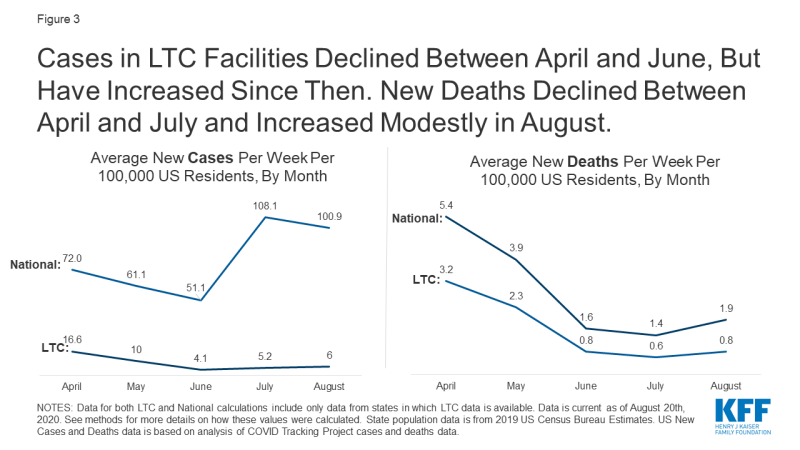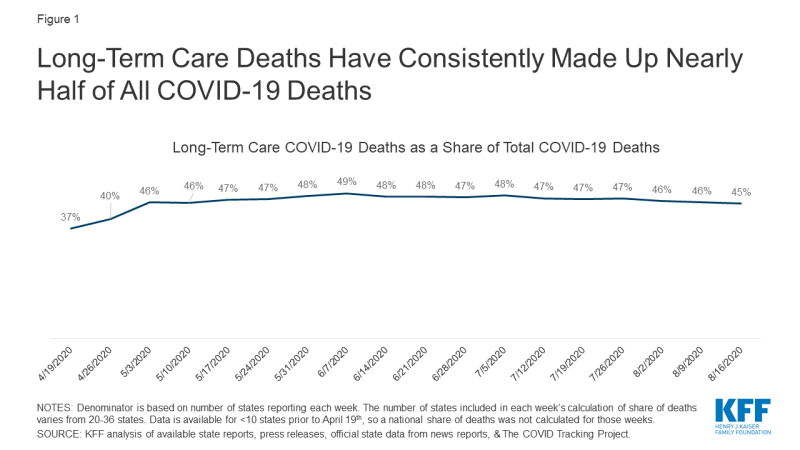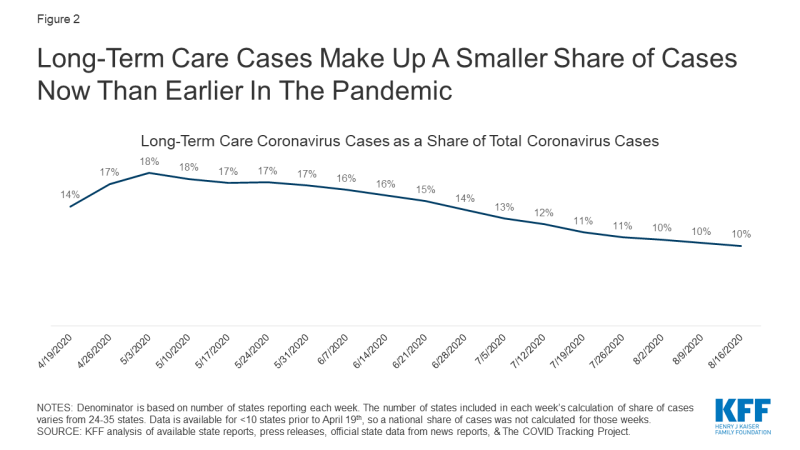Key Questions About the Impact of Coronavirus on Long-Term Care Facilities Over Time
Priya Chidambaram
Published:
1. How do trends in total cases and deaths in long-term care facilities vary by state?
Total cases and deaths in long-term care facilities have increased over time, with notable differences across states (Interactives 1 and 2). Examining visual trend lines in cumulative cases and deaths since April indicates that there are some states, such as New York, Massachusetts, New Jersey, and Connecticut, that have “flattened the curve”, while other states, such as California, Texas, Georgia, and Ohio, have continued to see a rise in long-term care cases and deaths (Interactives 1 and 2).
As of August 20th, states with the highest burden of COVID-19 long-term care cases and deaths per 100,000 state residents were among those that experienced the earliest peaks in both long-term care and overall cases and deaths (Table 1). New Jersey, Massachusetts, Louisiana, Rhode Island, and Connecticut had the highest burden of cases and deaths in LTC facilities per 100,000 state residents (>250 cases per 100,000 residents and >40 deaths per 100,000 residents) among all states that report data. With the exception of Louisiana, these states were also among the states that experienced relatively large numbers of long-term care cases and deaths in the earlier months of the pandemic (Interactives 1 and 2, Table 2).
In contrast, while long-term care cases and deaths in states like California and Texas continued to rise into the summer months, after other states had flattened their curve (Interactives 1 and 2, Table 2), these states experienced a smaller number of long-term care cases and deaths per 100,000 residents (11-12 deaths and 118 cases per 100,000 state residents) than states that peaked in March/April (>40 deaths and >250 cases per 100,000 state residents) (Table 1). With the number of cases and deaths in these states continuing to rise, it will be important to re-assess the extent to which this finding holds over time.
Interactive 1:
–
Interactive 2:
–
2. How has the national share of deaths and cases attributed to long-term care facilities changed over time?
Nationally, the share of deaths attributed to long-term care facilities has stayed relatively constant over time (Figure 1). The share of reported deaths attributed to long-term care facilities increased from 37% the week of April 19th to 46% the week of May 3rd and has stayed relatively constant since then. The increase in share of deaths attributed to LTC facilities from April to May may be attributed to better reporting (Figure 1). Notably, 7 additional states started reporting data on deaths between the week of April 19th and the week of May 3rd.
In contrast, the share of cases attributed to long-term care facilities has decreased over time. When long-term care data began to be reported by more states in mid-April, 1 in every 7 coronavirus cases was a long-term care facility resident or staff member. By the beginning of May, that share had increased to nearly 1 of every 5 cases. However, since then, the share of cases attributed to residents and staff in long-term care facilities has decreased. The most recent data from mid-August show that 1 in every 10 cases is a long-term care facility case (Figure 2). This decrease can likely be attributed to an increase in testing of the general population, most likely due to the increased community transmission that occurred in June and July.These new cases primarily skewed towards a younger population, so share of cases attributed to long-term care facilities has decreased.
3. What has happened with new cases and deaths in long-term care facilities nationally and at the state-level?
Nationally, new reported long-term care cases per week were the highest in April and decreased through May and June, before increasing again in July and August. (Figure 3 and Table 2). The number of new long-term care cases nationwide decreased from April to May (16.6 cases to 10.0 cases per 100,000 US residents) and again in June (4.1 cases per 100,000 US residents). However, beginning in July, new cases began to rise again (5.2 cases per 100,000 US residents) and again in August to 6.0 new long-term care cases per 100,000 US residents.

Figure 3: Cases in LTC Facilities Declined Between April and June, But Have Increased Since Then. New Deaths Declined Between April and July and Increased Modestly in August
New reported long-term care COVID-19 deaths per week were the highest in April, decreased through May, June, and July, before increasing modestly in August (Figure 3 and Table 2). New weekly long-term care deaths decreased from April to May (3.2 deaths to 2.3 deaths per 100,000 US residents), to June (0.8 deaths per 100,000 US residents), to July (to 0.6 deaths per 100,000 US residents) before increasing slightly in August to 0.8 deaths per 100,000 US residents.
The number of new LTC cases and deaths per 100,000 US residents was overall lower in July and August than in April and May. This pattern of new LTC cases differs from national new case trends, while the pattern of new LTC deaths is similar to national new death trends (Figure 3 and Table 2). New LTC outbreaks were more severe in the earliest months of the outbreak (primarily in the Northeast) than in more recent months, based on the lower number of new LTC cases and deaths per week (Figure 3 and Table 2). This pattern mirrors new deaths nationally, but is in contrast to national new case trends where, new cases in the general population were higher in July and August than in April and May (Figure 3). It is important to continue to track new LTC cases and deaths in the coming months to understand if we are at the beginning of a continued increase in new LTC cases and deaths that will outpace the rate of new cases and deaths identified in April and May.
Trends in long-term care facilities may mirror trends in community outbreaks, but may also be affected by measures that have been put in place to mitigate the impact of the pandemic on residents and staff. Trends of new cases and deaths, as well as recent analysis of cases and deaths by hotspot state status, support the idea that increased community transmission plays a role in increasing cases and deaths in long-term care facilities. However, nationally, long-term care facilities have seen less severe outbreaks now than they did earlier in the pandemic. While the severity of long-term care cases and outbreaks have decreased, potentially as a result of policies restricting visitors, implementing universal testing of staff and residents, and greater social distancing in communities, it will be important to look at burden of cases/deaths and new cases/deaths again if states experience a rise in cases and deaths in the community.


